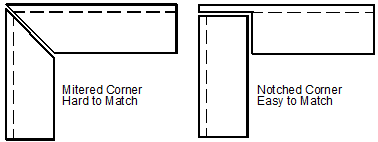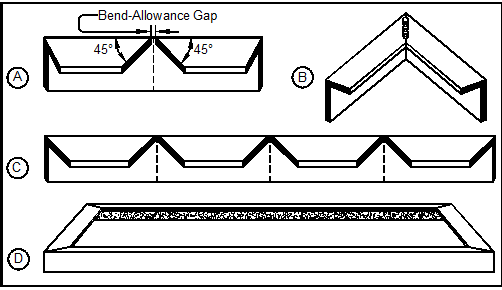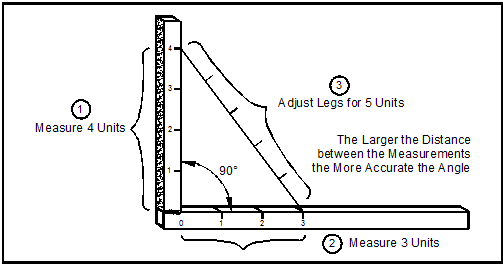- Preface
- Acknowledgements
- Chapter 1: Welding Overview
- Chapter 2: Safety
- Chapter 3: Terms, Joints, & Edge Preparation
- Chapter 4: Tools & Welding Tables
- Chapter 5: Shielded Metal Arc Welding
- Chapter 6: Wire Feed Welding
- Chapter 7: Gas Tungsten Arc Welding
- Chapter 8: Oxyacetylene
- Chapter 9: Controlling Distortion
- Chapter 10: Cutting Processes
- Chapter 11: Brazing & Soldering
- Chapter 12: Common Problems & Solutions
- Chapter 13: Design Tips
- Chapter 14: Fabrication & Repair Tips
- Chapter 15: Tools & Tooling
- Chapter 16: Pipe & Tubing
- Chapter 17: Metallurgy
- Chapter 18: Power Supplies & Electrical Safety
- Chapter 19: Bending & Straightening
- Index
- Credits
Chapter 14
Fabrication Tips
Everyone is a genius at least once a year. A real genius has his original ideas closer together.
—G.C. Lichtenberg
Section I – Frames & Brackets
Fabrication Steps
Many a good weld design is ruined by mistakes made in fabrication. This chapter will help you avoid the most common mistakes, and also a few uncommon mistakes. Though not all of the following steps are used on all projects, the typical weld fabrication steps are:
- Get or make a fabrication sketch or drawing.
- Develop a well thought out step-by-step procedure.
- Gather tools and materials.
- Make patterns, jigs, templates and fixtures, if needed.
- Put together a cut list.
- Lay out and cut the materials.
- Make edge preparations and clean the metal areas to be welded.
- Position and clamp materials prior to welding.
- Tack weld assemblies, check dimensions, setup and squareness.
- Place the final welds and assemble the final fabrication.
- Grind welds smooth only if necessary.
- Paint the fabrication, if needed.
Angle Iron Frame Corner Designs
There are three common methods for making corners on angle iron frames: mitering, notching, and notching and bending a single length of angle iron. Figure 14-1 shows mitering and notching.

Figure 14-1. Two corner joint designs using angle iron.
Both methods work, but with notching it is easier to get good results and this technique is more dimensionally tolerant because the joint gaps between the angle irons’ length can be adjusted to bring the frame square and the side lengths equal. After welding and grinding, both methods will look equally good and be equally strong. In general, use mitered corners when you have a bandsaw or a notching tool to cut perfectly matching corners.
The third approach for making square and rectangular frames from angle iron lends itself to production work because it requires notching and bending, which is best done on a machine like an Ironworker. These versatile machines can perform the functions of a press brake and a bending fixture, such as bending and notching angle iron. As shown in Figure 14-2, getting the correct bend-allowance gap is critical because this gap provides the extra material needed to go around the outside corner when the bend is made. To make these mitered and bent corners, begin by setting the bend-allowance gap to slightly less than the thickness of the angle iron and go from there. This method only works if corners are bent by machine. Heating the corners and manually freehand bending them will produce rounded corners—and scrap.

Figure 14-2. Notching and bending to make a single-piece frame: (A) corner detail before bending, (B) corner detail after bending, welding, and grinding, (C) notched angle iron frame ready for bending, and (D) the completed frame.
Checking for Squareness
There are several ways to check frames for squareness:
- When welding a very large L-shape, where a square is too small and there are no diagonals to measure, use a 3-4-5 triangle. Here’s how it’s done:
- Measure off four units on one leg, or member, of the frame.
- Measure off three units on the other leg.
- Adjust the hypotenuse by moving either leg of the L-shape until the hypotenuse measures exactly 5 units. Following this procedure makes a perfect right triangle. See Figure 14-3.

Figure 14-3. Using a 3-4-5 triangle to set members at a right angle. Remember to reduce the overall length of the frame sides to allow for additional joint root spacing, otherwise your frame will be oversized.
- Check for equal diagonals between opposite frame corners using a steel measuring tape. This method is used in Figure 14-7.
- On large frames, check the squareness using a carpenter’s square, and on smaller frames, check squareness using a machinist’s square.
- If the sides of the frame are to be plumb and level, a large level can be used.
Improving the Odds of a Welded Frame Being Square In decreasing order of effectiveness:
- Secure all members in a rigid fixture, tack them, weld them, and let them cool down in the fixture. This is the best method.
- Clamp members to a steel table and then tack and weld them.
- Use a fixture to hold members for tacking, then weld the tacked members outside of the fixture. This fixture can be as simple as a sheet of plywood with wood blocks fixed to it to hold the work in place while the tack welds are made. For an example of this type of fixture, see Figure 14-4.
- When tacking is complete and you have checked the frame for squareness, weld one corner, and then weld the opposite corner. Weld the same relative corner in the exact same sequence on all four corner joints. Next, weld all outside faces, then all top corners, and finally all bottom faces. Make each weld in the same relative direction and give each weld time to cool before starting the next weld.
- Begin by tack welding each of the corners together using a Bessy-type clamp each time, then check for squareness. If needed, bend the part back into squareness. If the tack welds are not too large, with moderate force you will be able to straighten the frame by hand without using hydraulic jacks. After tacking, begin your final welds at opposite corners.
The Around-The-World Rule: Do not start welding at one end and travel sequentially using a corner clamp—the last two corner pieces of the frame probably will not meet.
- Use magnetic corner tools. These are effective only for light sheet metal and light angle iron because they lack the strength to resist weld-induced distortion—but they will allow you to place initial tack welds.

